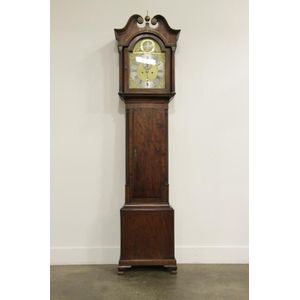Robert Mason Oak Longcase Clock, 1820-1830
You must be a subscriber, and be logged in to view price and dealer details.
Subscribe Now to view actual auction price for this item
When you subscribe, you have the option of setting the currency in which to display prices to $Au, $US, $NZ or Stg.
- Oak - Native to Europe and England, oak has been used for joinery, furniture and building since the beginning of the medieval civilisation. It is a pale yellow in colour when freshly cut and darkens with age to a mid brown colour.
Oak as a furniture timber was superceded by walnut in the 17th century, and in the 18th century by mahogany,
Semi-fossilised bog oak is black in colour, and is found in peat bogs where the trees have fallen and been preserved from decay by the bog. It is used for jewellery and small carved trinkets.
Pollard oak is taken from an oak that has been regularly pollarded, that is the upper branches have been removed at the top of the trunk, result that new branches would appear, and over time the top would become ball-like. . When harvested and sawn, the timber displays a continuous surface of knotty circles. The timber was scarce and expensive and was used in more expensive pieces of furniture in the Regency and Victorian periods. - Circa - A Latin term meaning 'about', often used in the antique trade to give an approximate date for the piece, usually considered to be five years on either side of the circa year. Thus, circa 1900 means the piece was made about 1900, probably between 1895 and 1905. The expression is sometimes abbreviated to c.1900.
- Hood - In longcase clocks, the hood is the wooden case that surrounds the works and dial, and includes the glass front, which is usually hinged, so the door can be opened to wind the clock or adjust the time. In 18th and 19th century longcase clocks the hood usually slides forward for removal, allowing access to the works.
This item has been included into following indexes:
Visually similar items

An early 19th century mahogany cased grandfather clock the brass dial with a silvered chapter ring signed Geo. Bruce London. Height 218 cm. Width 45 cm. Depth 22 cm

Antique English long case clock, movement by Jas Roberts (Bath) painted arched dial, with sub seconds, and calendar aperture, ebony inlaid mahogany case, approx 210 cm high

George III mahogany long case clock, the broken arch bonnet enclosing a hand painted dial with Arabic numerals, subsidiary dials for seconds and date, signed 'Baker Dunster', the arch with aperture for rocking sailing ship, single panelled door, two brass

A Georgian oak and mahogany cased arch brass dial and painted panel grandfather clock. Maker: John Laurence of Lancaster. 231 cm high, 50 cm wide, 25 cm deep.
